Projected Changes in Dry and Wet Spells over West Africa during Monsoon Season Using Markov Chain Approach
Abstract
1. Introduction
2. Data and Methods
2.1. Data
2.2. Methods
3. Results and Discussion
3.1. Spatial Variability of Summer Rainfall
3.2. Spatial Variability of Summer Probabilities
3.3. Mean Changes in Dry and Wet Spells
3.4. Interannual Variability of Probabilities
3.5. Dry and Wet Spell Probability Uncertainties in the West Africa Sub-Domains
4. Conclusions
Author Contributions
Funding
Data Availability Statement
Acknowledgments
Conflicts of Interest
Appendix A
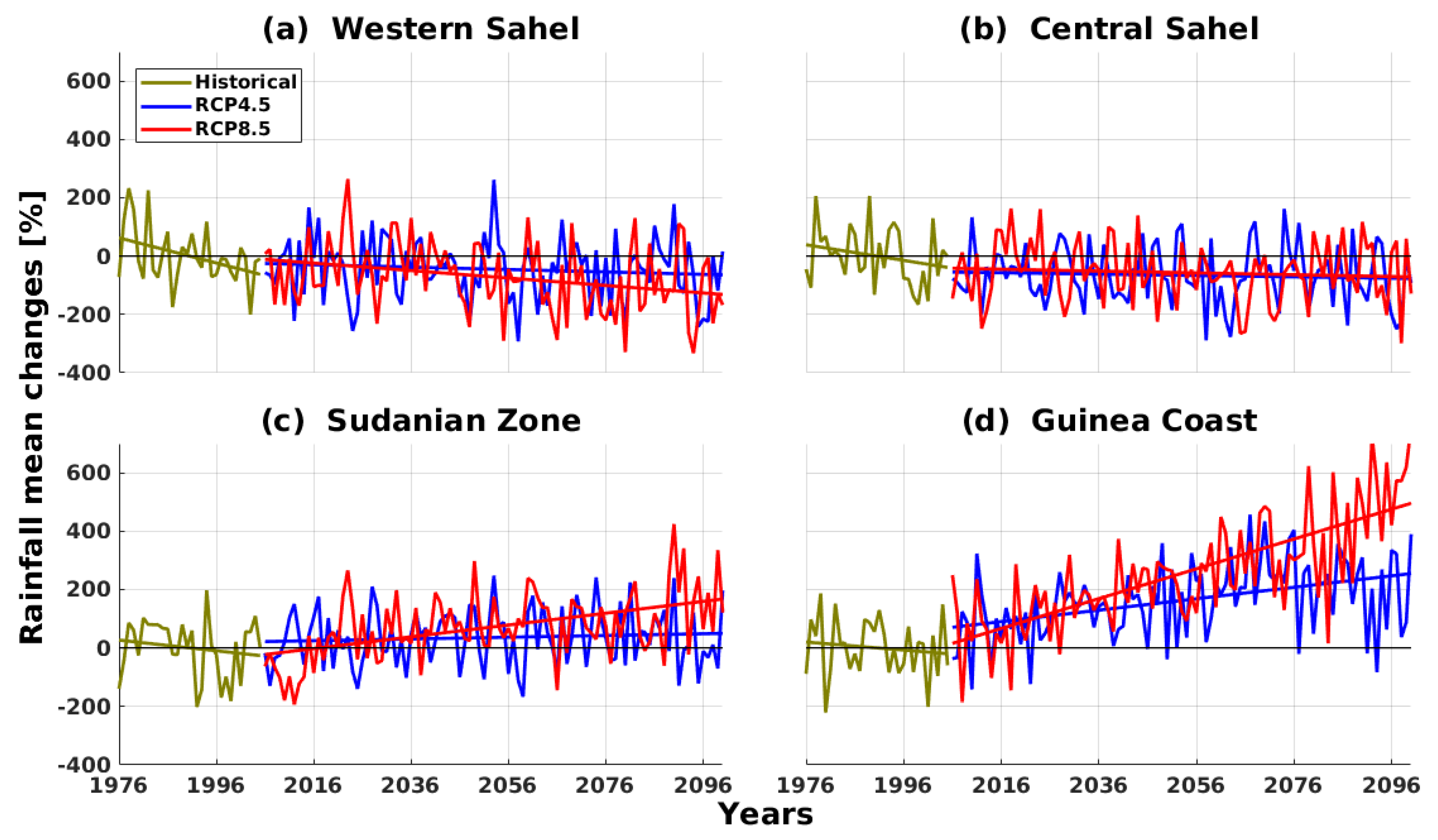
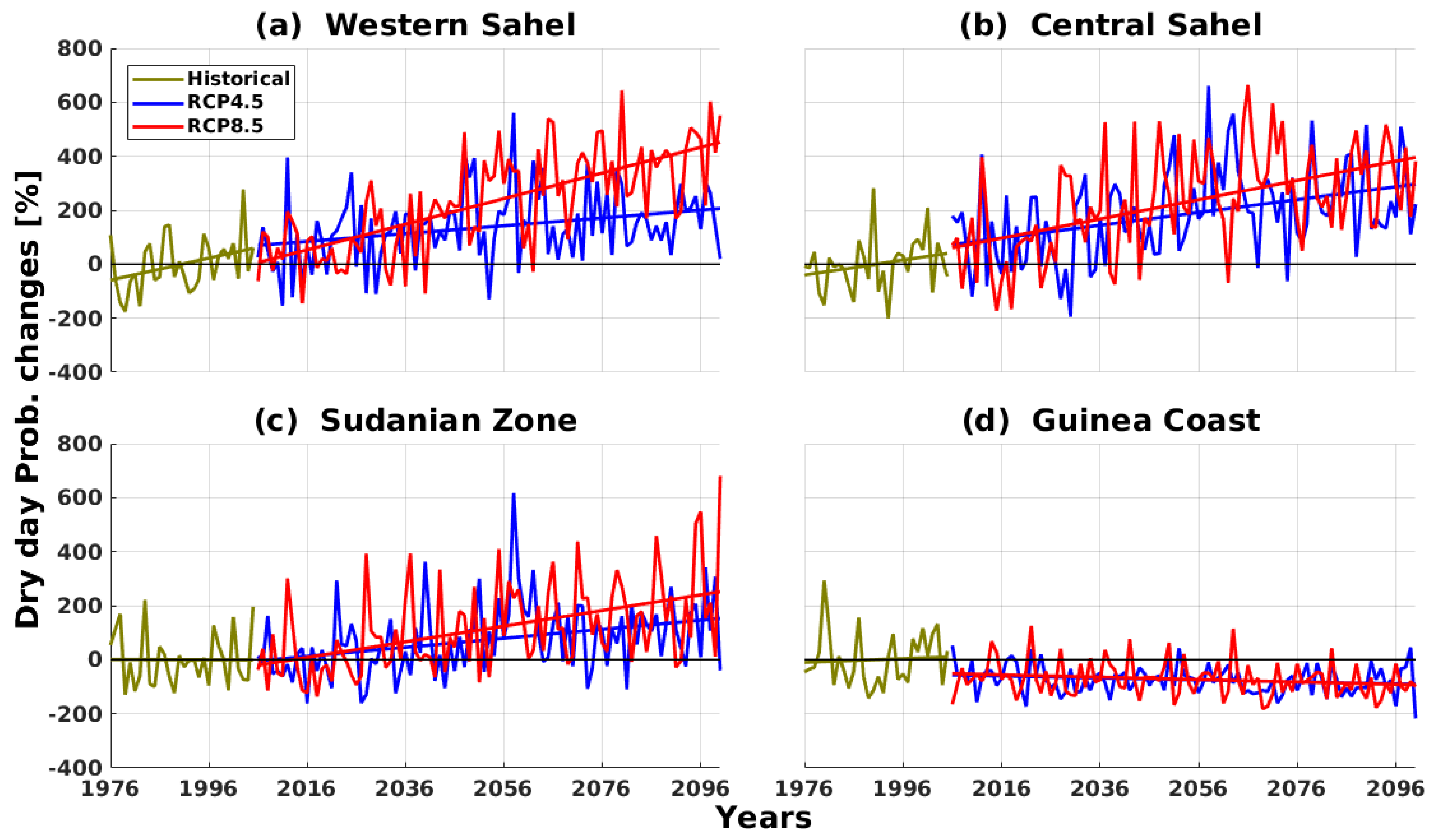


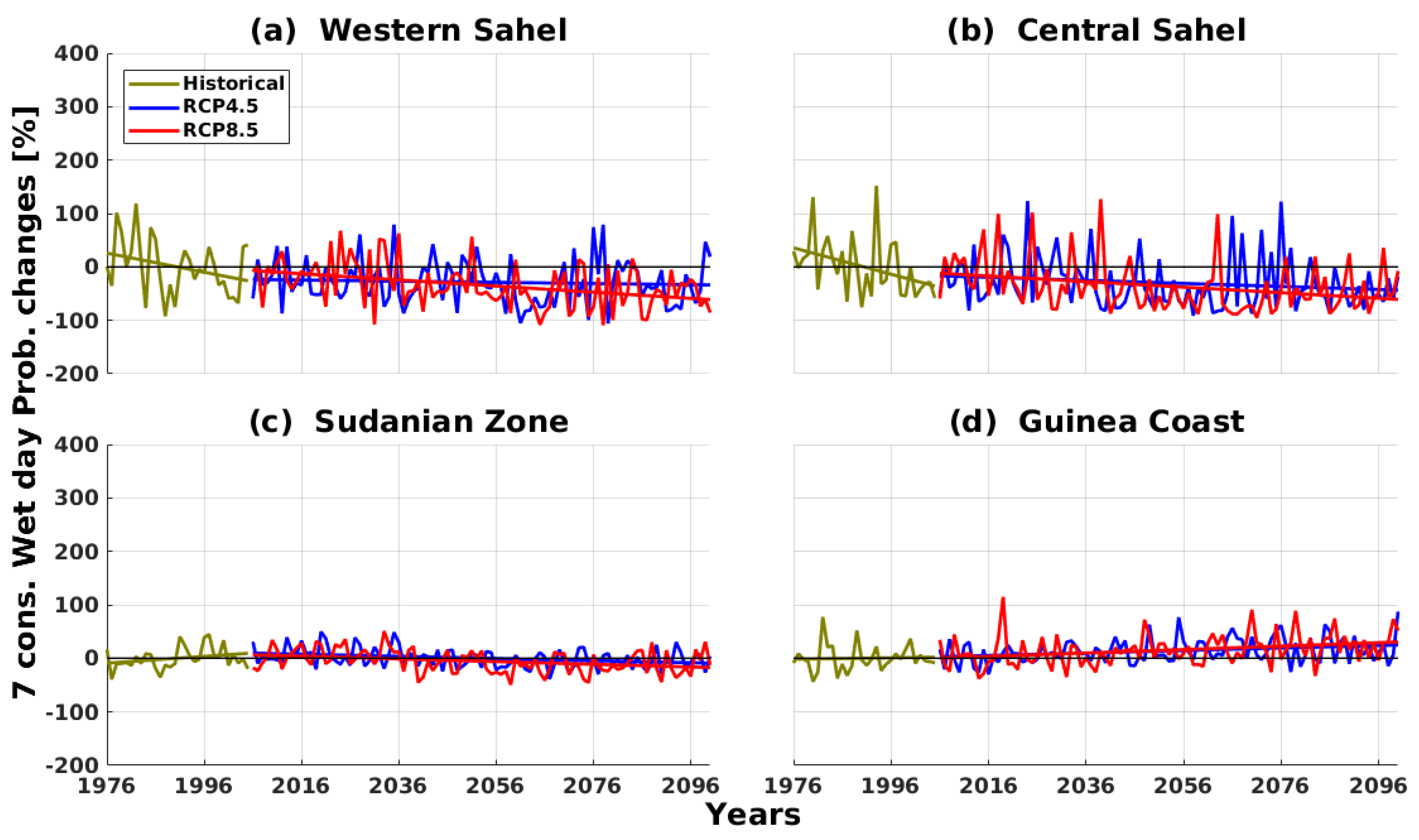


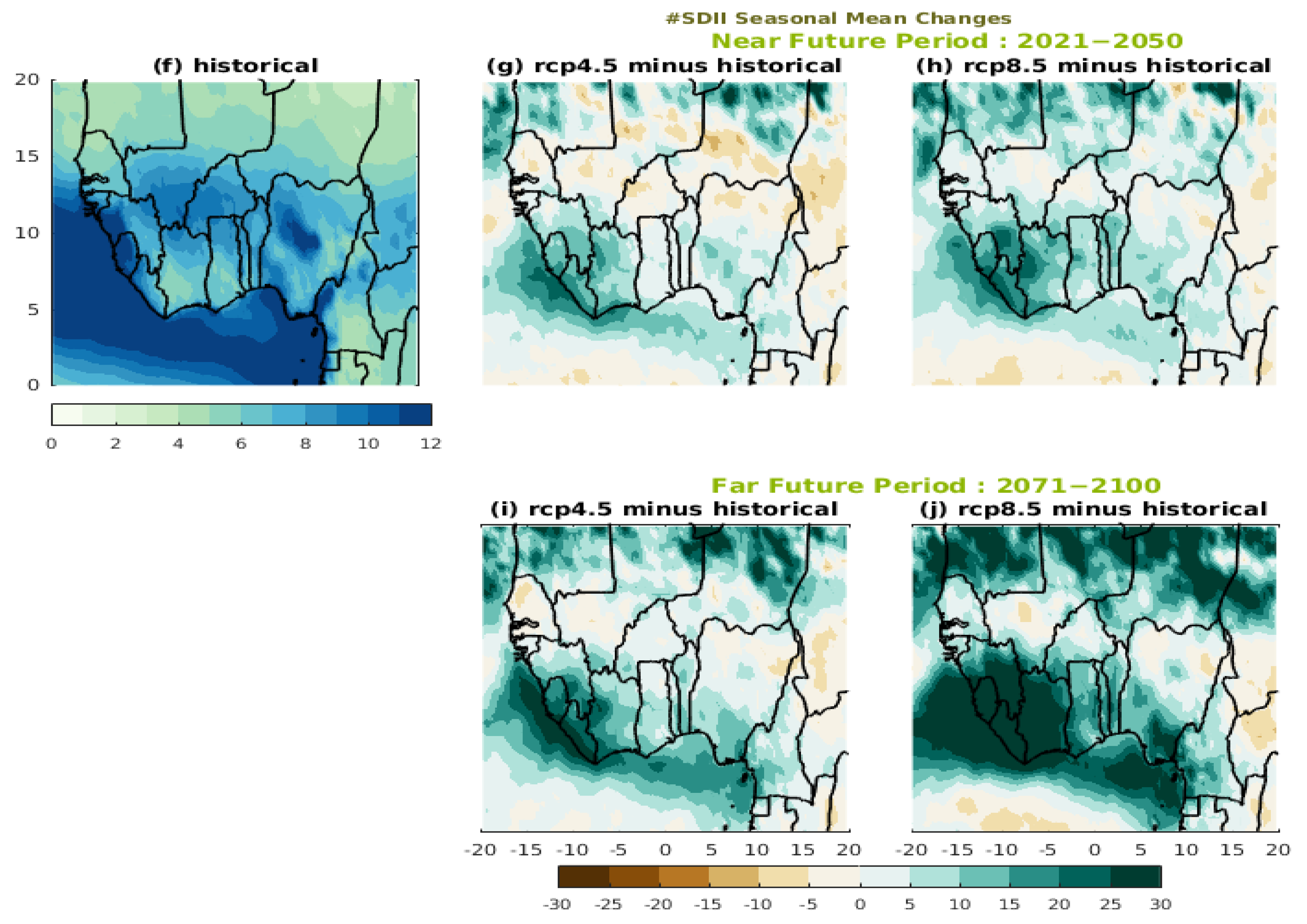
References
- Krishnan, R.; Sanjay, J. Climate Change over INDIA: An Interim Report; Centre for Climate Change Reseach (CCCR): Pune, India, 2017. [Google Scholar]
- Nkrumah, F.; Vischel, T.; Panthou, G.; Klutse, N.A.B.; Adukpo, D.C.; Diedhiou, A. Recent Trends in the Daily Rainfall Regime in Southern West Africa. Atmosphere 2019, 10, 741. [Google Scholar] [CrossRef]
- Ta, S.; Kouadio, K.Y.; Ali, K.E.; Toualy, E.; Aman, A.; Yoroba, F. West Africa Extreme Rainfall Events and Large-Scale Ocean Surface and Atmospheric Conditions in the Tropical Atlantic. Adv. Meteorol. 2016, 2016, 1940456. [Google Scholar] [CrossRef]
- Sylla, M.B.; Giorgi, F.; Pal, J.S.; Gibba, P.; Kebe, I.; Nikiema, M. Projected changes in the annual cycle of high intensity precipitation events over West Africa for the late 21st century. J. Clim. 2015, 28, 6475–6488. [Google Scholar] [CrossRef]
- Sarr, A.B.; Camara, M. Evolution des indices pluviométriques extrêmes par l’analyse de modèles climatiques régionaux du programme CORDEX: Les projections climatiques sur le Sénégal. Eur. Sci. J. 2017, 13, 26. [Google Scholar] [CrossRef]
- Diedhiou, A.; Bichet, A.; Wartenburger, R.; Seneviratne, S.I.; Rowell, D.P.; Sylla, M.B.; Diallo, I.; Todzo, S.; Touré, N.E.; Camara, M.; et al. Changes in climate extremes over West and Central Africa at 1.5 °C and 2 °C global warming. Environ. Res. Lett. 2018, 13, 065020. [Google Scholar] [CrossRef]
- Ogega, O.M.; Gyampoh, B.A.; Mistry, M.N. Intraseasonal Precipitation Variability over West Africa under 1.5 °C and 2.0 °C Global Warming Scenarios: Results from CORDEX RCMs. Climate 2020, 8, 143. [Google Scholar] [CrossRef]
- Yapo, A.L.M.; Diawara, A.; Kouassi, B.K.; Yoroba, F.; Sylla, M.B.; Kouadio, K.; Tiémoko, D.T.; Koné, D.I.; Akobé, E.Y.; Yao, K.P.A.T. Projected changes in extreme precipitation intensity and dry spell length in Côte d’Ivoire under future climates. Theor. Appl. Clim. 2020, 140, 871–889. [Google Scholar] [CrossRef]
- Klein Tank, A.M.G.; Zwiers, F.W.; Zhang, X. Guidelines on Analysis of Extremes in a Changing Climate in Support of Informed Decisions for Adaptation; Climate data and monitoring WCDMP-No. 72, WMO-TD No. 1500; WMO: Geneva, Switzerland, 2009; p. 56. [Google Scholar]
- Froidurot, S.; Diedhiou, A. Characteristics of wet and dry spells in the West African monsoon system. Atmos. Sci. Lett. 2017, 18, 125–131. [Google Scholar] [CrossRef]
- Biao, E.I.; Alamou, E.A. Stochastic Modelling of Daily Rainfall for Decision Making in Water Management in Benin (West Africa). Res. J. Adv. Environ. Sci. 2018, 1, 12–21. [Google Scholar]
- Ayanlade, A.; Radeny, M.; Morton, J.F.; Muchaba, T. Rainfall variability and drought characteristics in two agro-climatic zones: An assessment of climate change challenges in Africa. Sci. Total Environ. 2018, 630, 728–737. [Google Scholar] [CrossRef]
- Sen, Z. Regional Wet and Dry spell analysis with heterogeneous probability occurrences. J. Hydrol. Eng. 2015, 20, 04014094. [Google Scholar] [CrossRef]
- Pandarinath, N. Markov chain model probability of dry and wet weeks during monsoon periods over Andhra Pradesh. Mausam 1991, 42, 393–400. [Google Scholar] [CrossRef]
- Rockström, J.; Barron, J.; Fox, P. Rainwater management for increased productivity among small-holder farmers in drought prone environments. Phys. Chem. Earth 2002, 27, 949–959. [Google Scholar] [CrossRef]
- Basse, J.; Camara, M.; Diba, I.; Diedhiou, A. Probability of dry and wet spells over West Africa during the summer monsoon season. Sci. Res. Essays 2021, 16, 20–35. [Google Scholar] [CrossRef]
- Giorgi, F.; Jones, C.; Asrar, G.R. Addressing climate information needs at the regional level: The CORDEX framework. WMO Bull. 2009, 58, 175–183. [Google Scholar]
- Jones, C.G.; Giorgi, F.; Asrar, G. The Coordinated Regional Downscaling Experiment (CORDEX); An International Downscaling Link to CMIP5; CLIVAR Exchanges; International CLIVAR Project Office: Southampton, UK, 2011; pp. 34–39. [Google Scholar]
- Hewitson, B.C.; Lennard, C.; Nikulin, G.; Jones, C. CORDEX-Africa: A unique opportunity for science and capacity building. CLIVAR Exch. 2012, 17, 6–7. [Google Scholar]
- Nikulin, G.; Jones, C.; Giorgi, F.; Asrar, G.; Büchner, M.; Cerezo-Mota, R.; Christensen, O.B.; Déqué, M.; Fernandez, J.; Hänsler, A.; et al. Precipitation climatology in an ensemble of CORDEX-Africa regional climate simulations. J. Clim. 2012, 25, 6057–6078. [Google Scholar] [CrossRef]
- Mbaye MLSylla, M.B.; Tall, M. Impacts of 1.5 and 2.0 °C Global Warming on Water Balance Components over Senegal in West Africa. Atmosphere 2019, 10, 712. [Google Scholar] [CrossRef]
- Coulibaly, N.; Coulibaly, T.; Mpakama, Z.; Savané, I. The impact of climate change on water resource availability in a trans-boundary basin in West Africa: The case of Sassandra. Hydrology 2018, 5, 12. [Google Scholar] [CrossRef]
- Lawin, A.E.; Hounguè, R.; N’Tcha M’Po, Y.; Hounguè, N.R.; Attogouinon, A.; Afouda, A.A. Mid-century climate change impacts on Ouémé River discharge at bonou outlet (Benin). Hydrology 2019, 6, 72. [Google Scholar] [CrossRef]
- Koffi, B.; Brou, A.L.; Kouadio, K.J.O.; Ebodé, V.B.; N’guessan, K.J.Y.; Yangouliba, G.I.; Yaya, K.; Brou, D.; Kouassi, K.L. Impact of climate and land use/land cover change on Lobo reservoir inflow, West-Central of Côte d’Ivoire. J. Hydrol. Reg. Stud. 2023, 47, 101417. [Google Scholar] [CrossRef]
- Barredo, J.I.; Caudullo, G.; Mauri, A. Mediterranean Habitat Loss under RCP4.5 and RCP8.5 Climate Change Projections: Assessing Impacts on the Natura 2000 Protected Area Network; EUR 28547 EN; Publications Office of the European Union: Luxembourg, 2017. [Google Scholar]
- Diallo, I.; Sylla, M.B.; Giorgi, F.; Gaye, A.T.; Camara, M. Multimodel GCM-RCM ensemble-based projections of temperature and precipitation over West Africa for the early 21st century. Int. J. Geophys. 2012, 2012, 972896. [Google Scholar] [CrossRef]
- Bichet, A.; Diedhiou, A. West African Sahel has become wetter during the last 30 years but dry spells are shorter and more frequent. Clim. Res. 2018, 75, 155–162. [Google Scholar] [CrossRef]
- Fall, C.M.N.; Lavaysse, C.; Kerdiles, H.; Dramé, M.S.; Roudier, P.; Gaye, A.T. Performance of dry and wet spells combined with far sensing indicators for crop yield prediction in Senegal Stern. Nat. Hazards Earth Syst. Sci. 2021, 21, 1051–1069. [Google Scholar] [CrossRef]
- Ray, M.; Biswasi Sahoo Patro, H. A Markov Chain Approach for Wet and Dry Spell and Probability Analysis. Int. J. Curr. Microbiol. Appl. Sci. 2018, 6, 1005–1013. [Google Scholar]
- Ouédraogo, P.L.A.; Zorom, M.; Niang, D.; Fossi, S. Prédétermination des Séquences Sèches et Intérêt de L’information Climatique sur la Production Céréalière en Zone Sahélienne. Master’s Thesis, Institut International d’Ingénierie, Ouagadougou, Burkina Faso, 2013; 61p. [Google Scholar]
- Sylla, M.B.; Nikiema, P.M.; Gibba, P.; Kebe, I.; Klutse, N.A.B. Climate Change over West Africa: Recent Trends and Future Projections. In Adaptation to Climate Change and Variability in Rural West Africa; Yaro, J., Hesselberg, J., Eds.; Springer: Cham, Switzerland, 2016; pp. 25–40. [Google Scholar] [CrossRef]
- Saley, I.A.; Salack, S. Present and Future of Heavy Rain Events in the Sahel and West Africa. Atmosphere 2023, 14, 965. [Google Scholar] [CrossRef]
- Roudier, P.; Muller, B.; D’aquino, P.; Roncoli, C.; Soumaré, M.; Batté, L.; Sultan, B. The role of climate forecasts in smallholder agriculture: Lessons from participatory research in two communities in Senegal. Clim. Risk Manag. 2014, 2, 42–55. [Google Scholar] [CrossRef]
- Dunning, C.M.; Black, E.; Allan, R.P. Later Wet Seasons with More Intense Rainfall over Africa under Future Climate Change. J. Clim. 2018, 31, 9719–9738. [Google Scholar] [CrossRef]
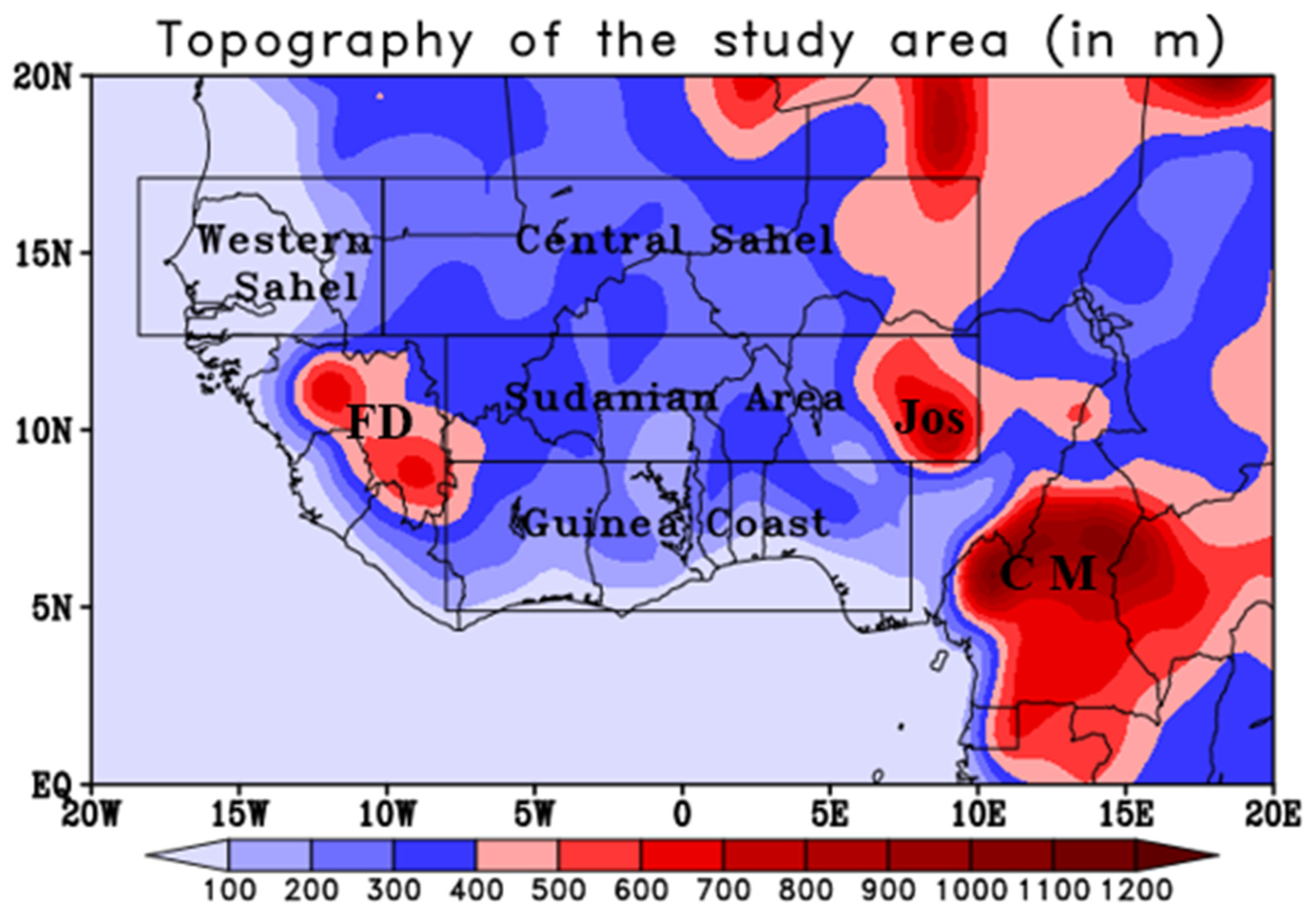
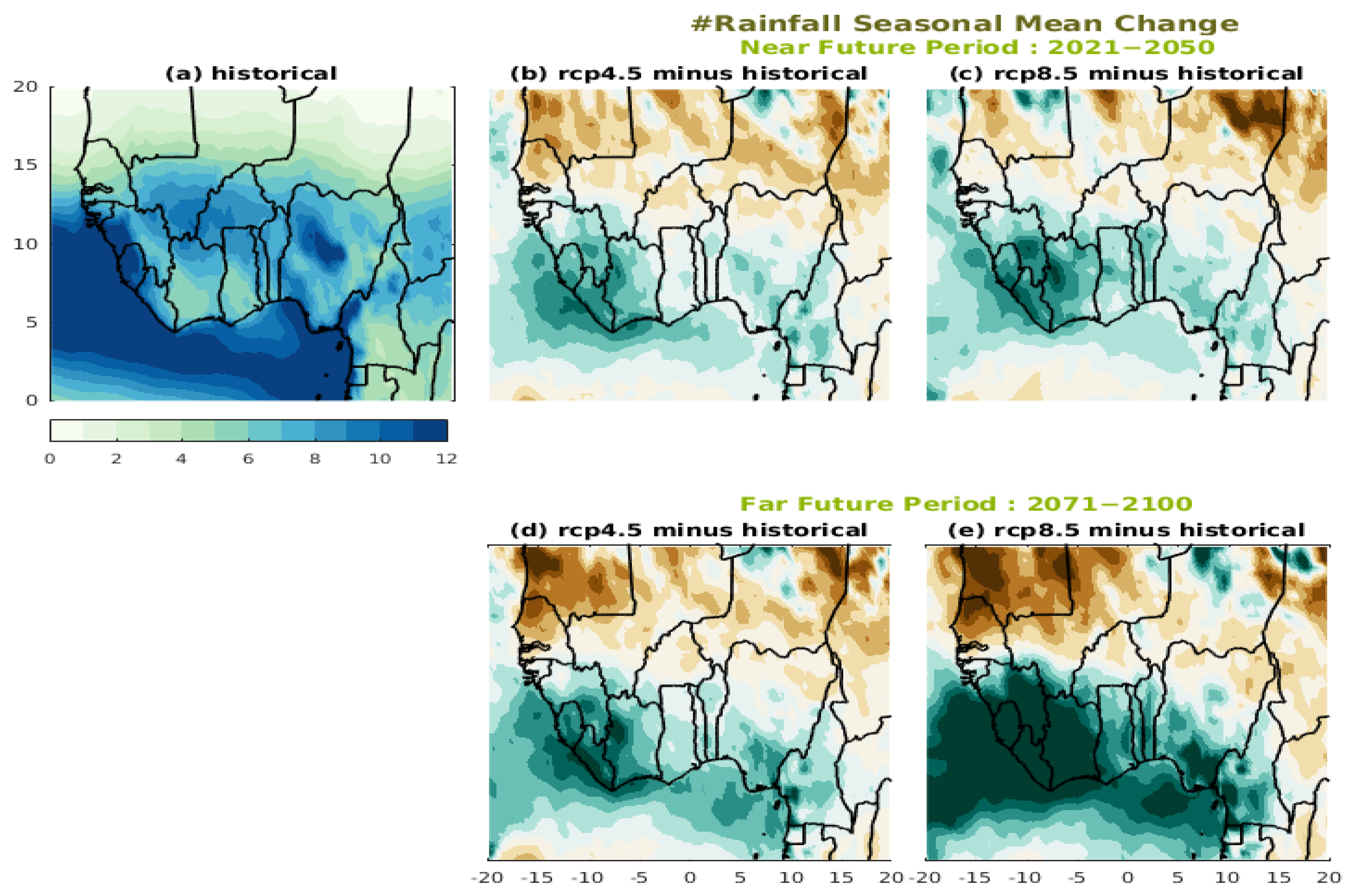


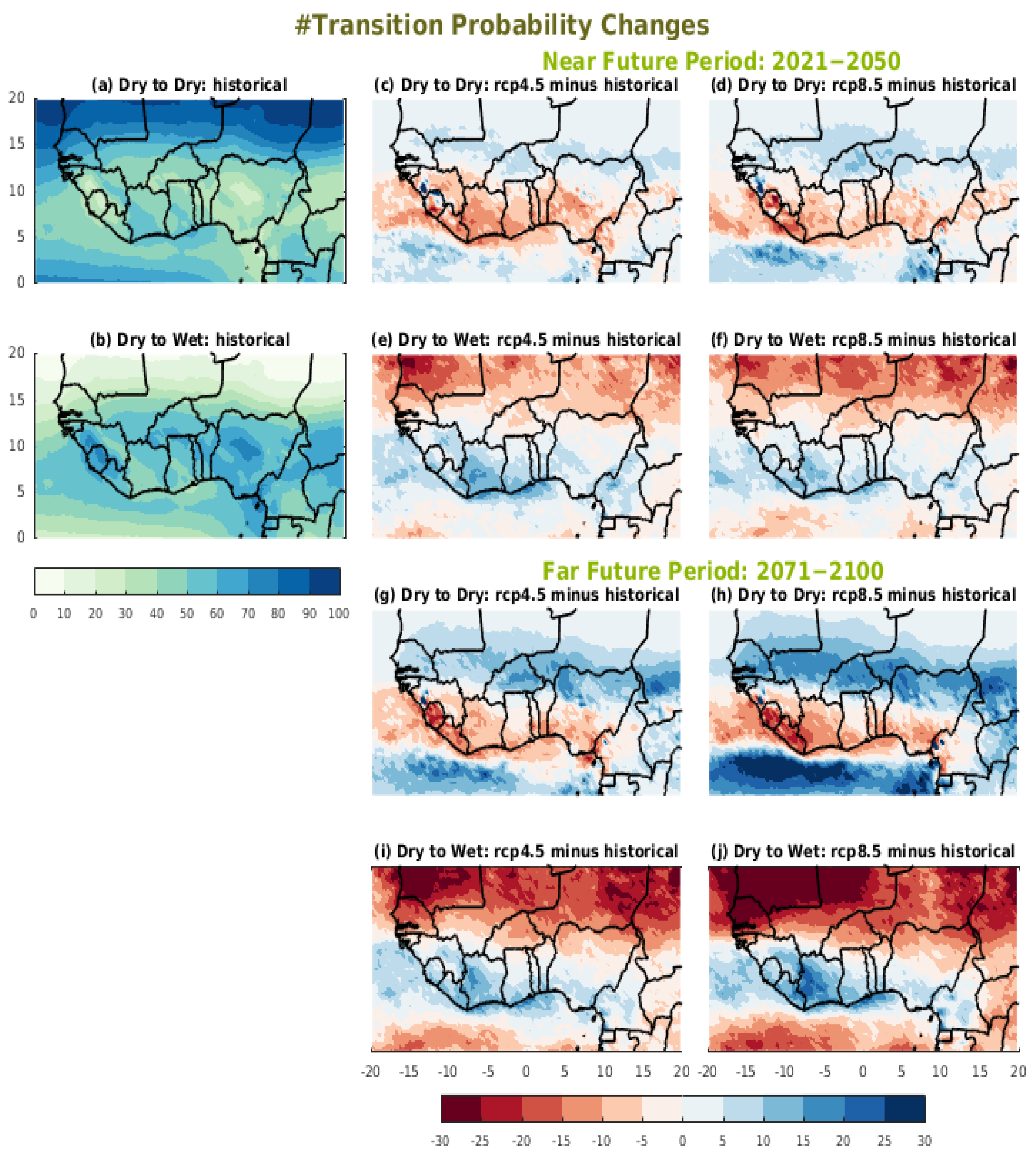

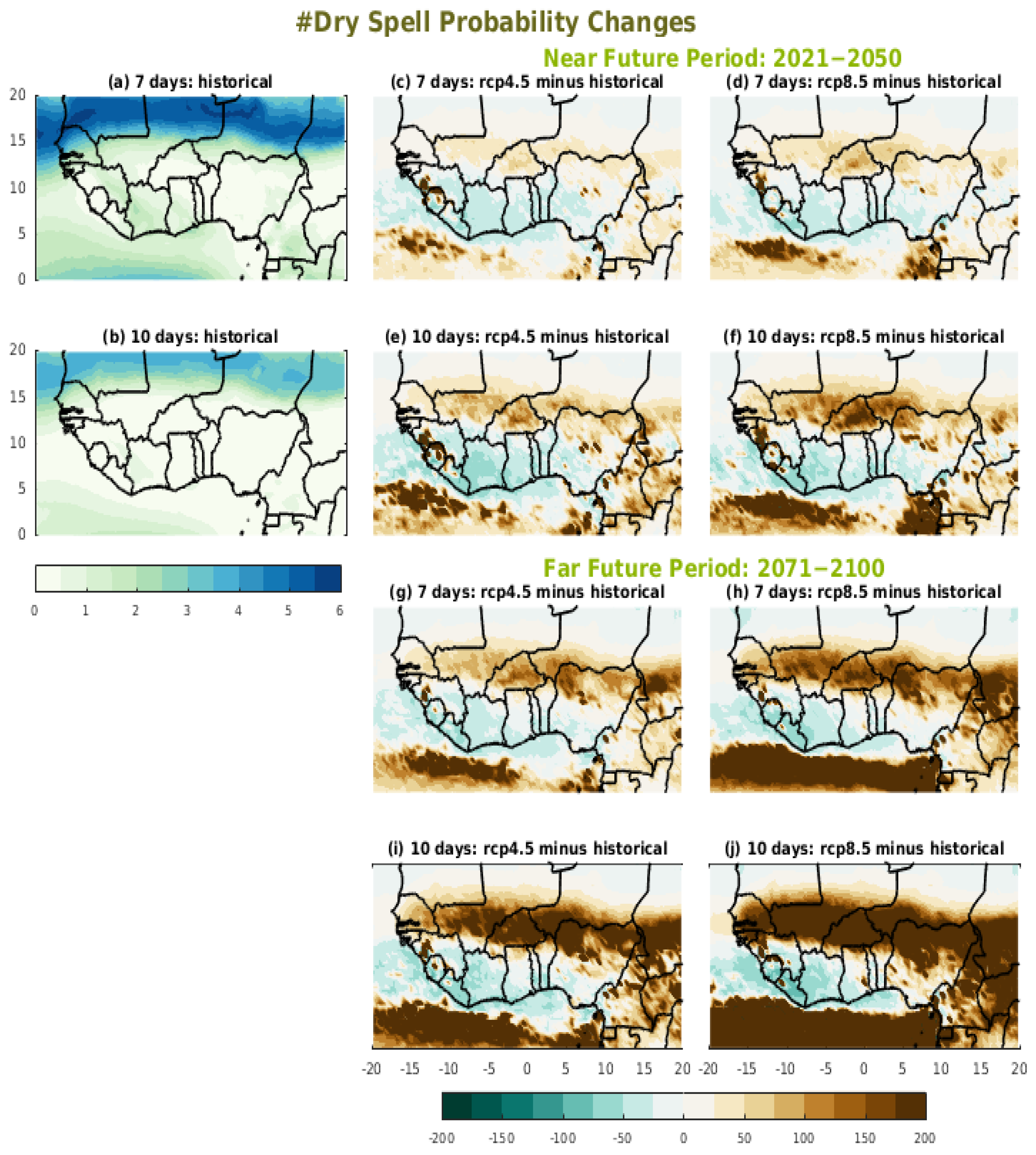
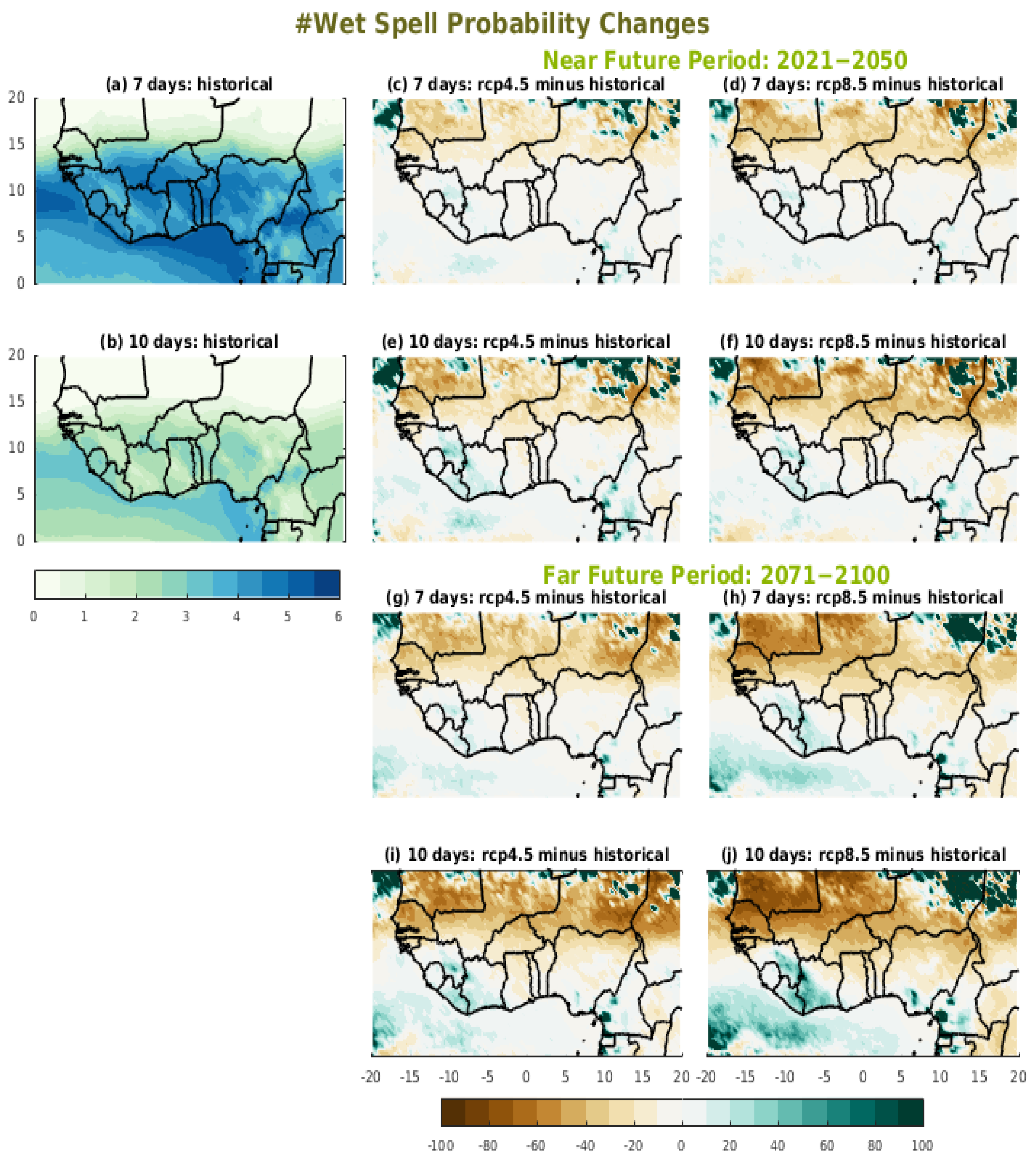

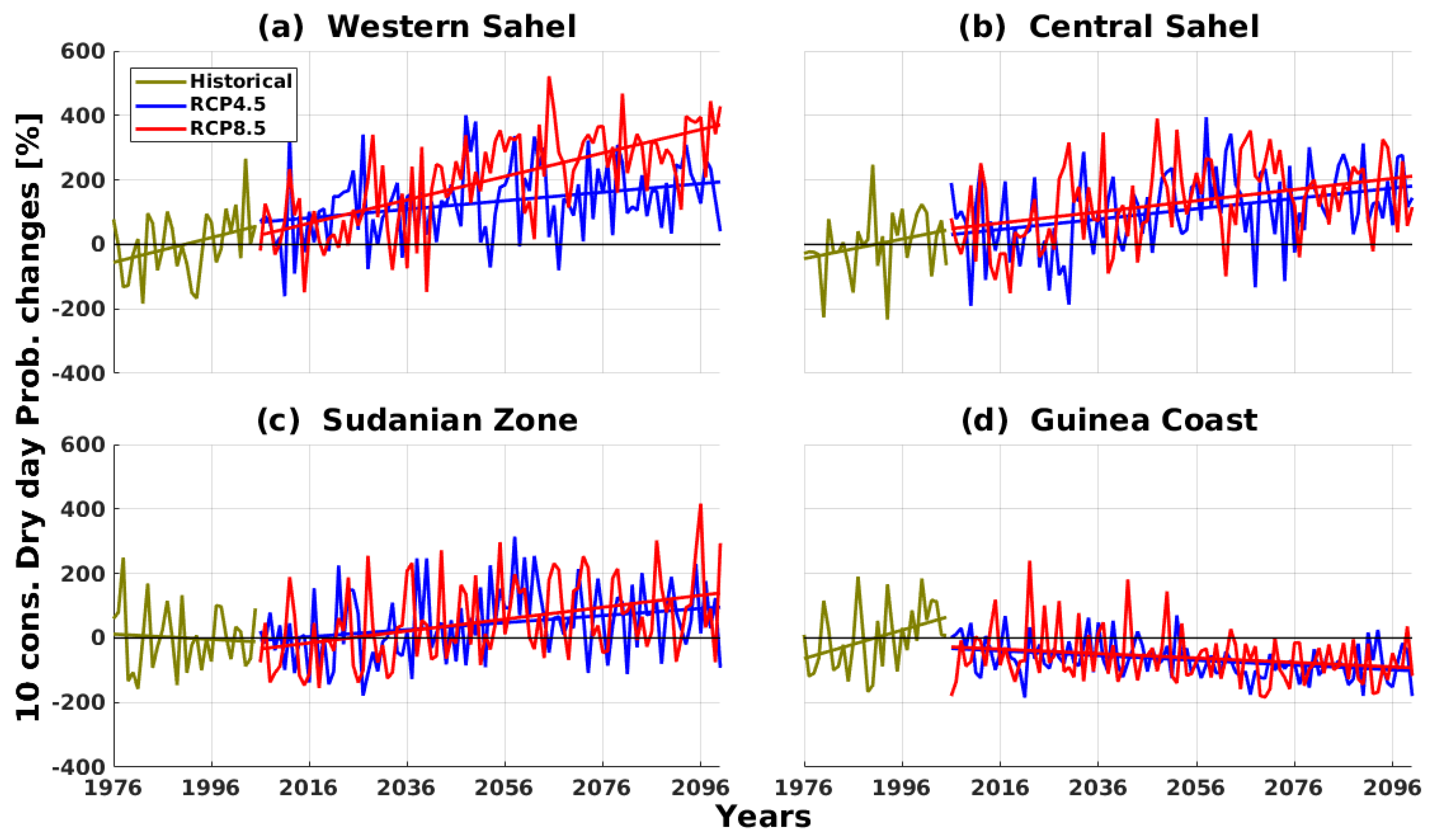

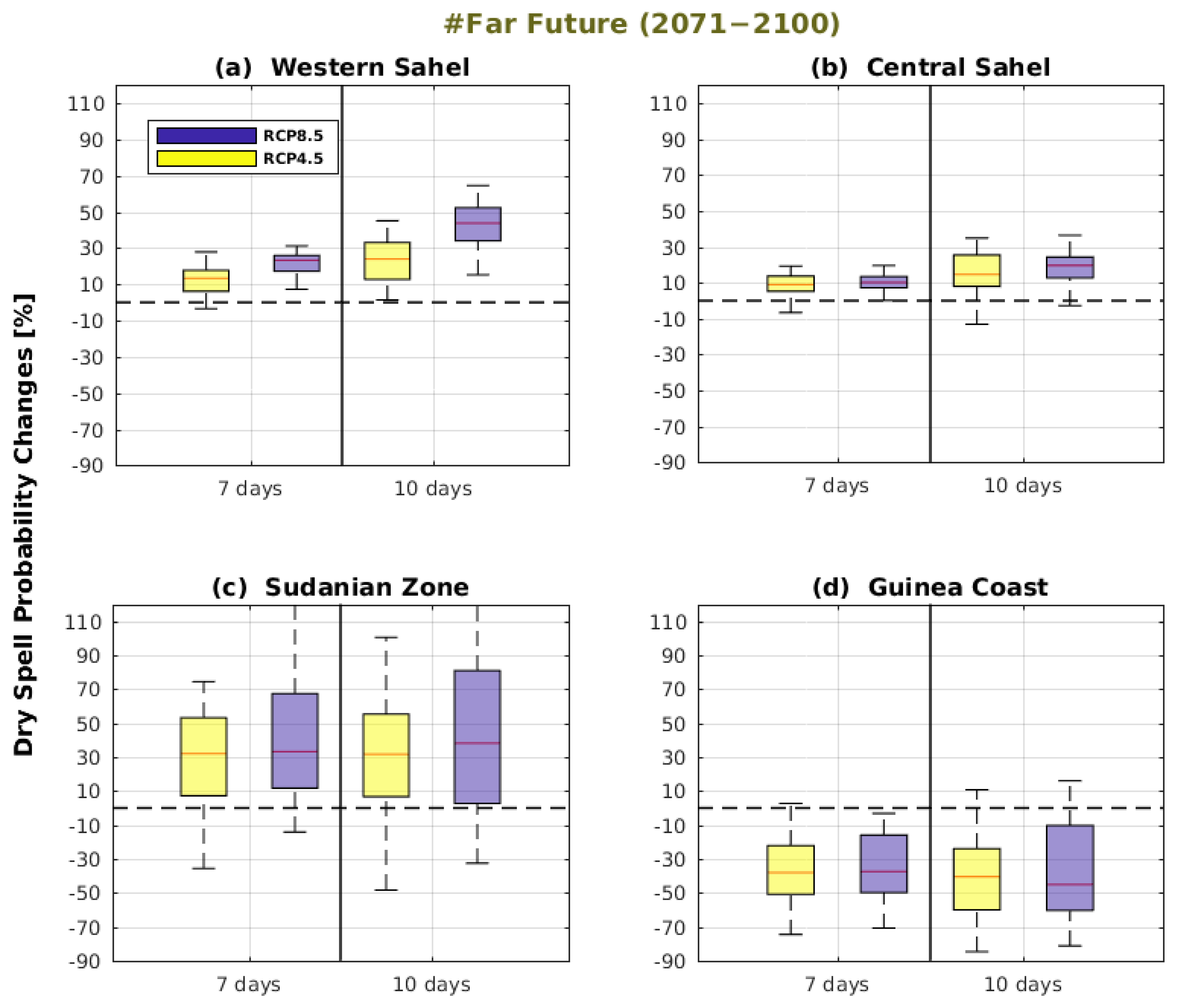

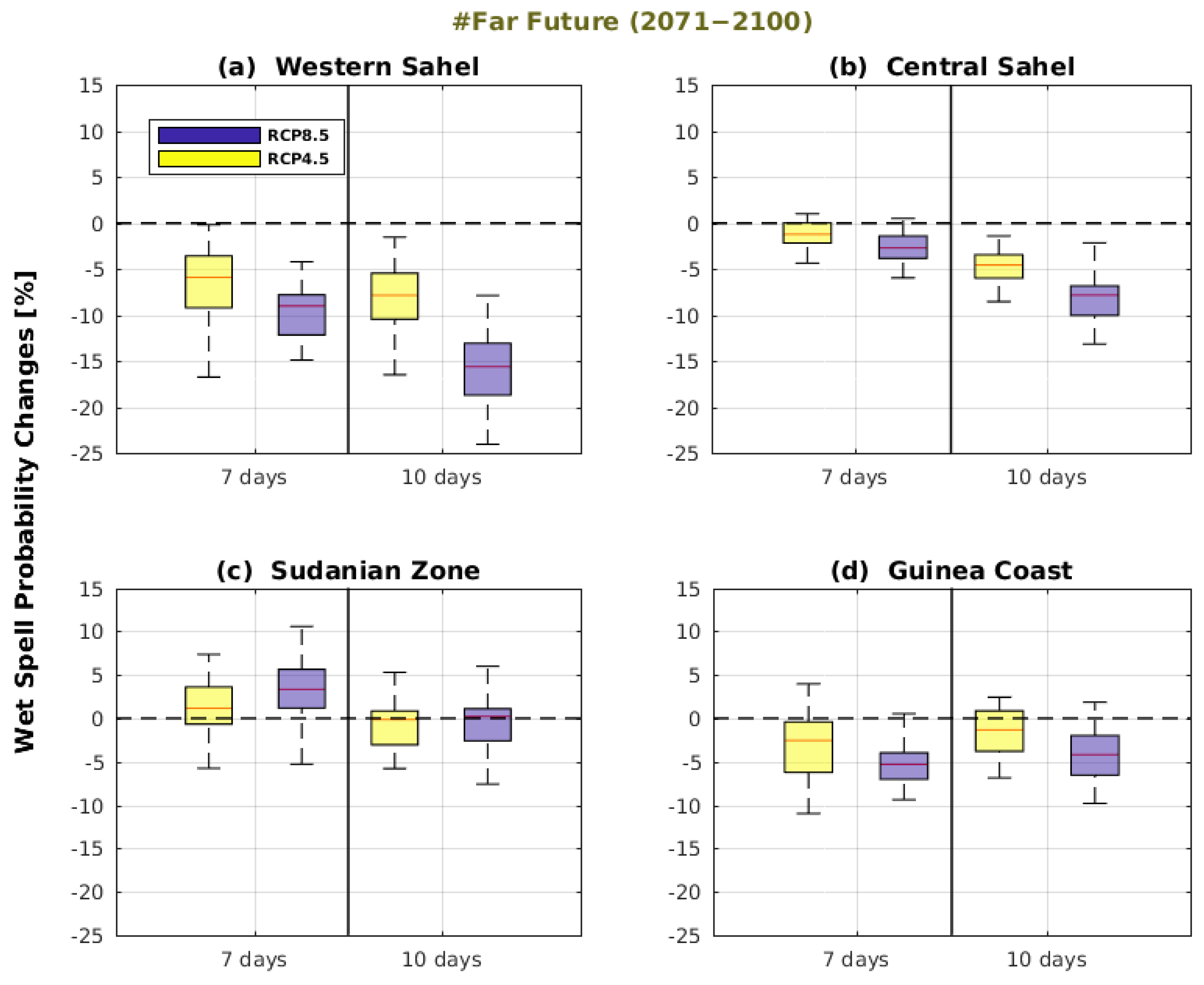
| Driving GCM | Institute | RCM | Historical Period | Projection Periods |
|---|---|---|---|---|
| MPI | REMO | 1976–2005 | 2021–2050; 2071–2100 | |
| ICHEC-EC-EARTH | KNMI | RACMO22T | 1976–2005 | 2021–2050; 2071–2100 |
| DMI | HIRHAM5 | 1976–2005 | 2021–2050; 2071–2100 | |
| CNRM-CERFACS | CLMcom | CCLM4-8-17 | 1976–2005 | 2021–2050; 2071–2100 |
| Periods | 2021–2050 | 2071–2100 | ||
|---|---|---|---|---|
| Scenarios | RCP4.5 | RCP8.5 | RCP4.5 | RCP8.5 |
| Rainfall JAS mean | ||||
| Western Sahel | −5.71 | −1.44 | −10.04 | −13.22 |
| Central Sahel | −6.04 | −3.00 | −7.46 | −6.55 |
| Sudanian Area | 1.71 | 5.67 | 3.13 | 8.28 |
| Guinea Coast | 7.51 | 10.94 | 12.58 | 26.07 |
| Very wet days (R95P) JAS mean | ||||
| Western Sahel | −1.84 | 3.96 | −2.74 | −1.3 |
| Central Sahel | −3.9 | 2.36 | 0.89 | 5.43 |
| Sudanian Area | 4.88 | 12.61 | 9.99 | 21.85 |
| Guinea Coast | 7.86 | 15.63 | 16.76 | 35.31 |
| Periods | 2021–2050 | 2071–2100 | ||
|---|---|---|---|---|
| Scenarios | RCP4.5 | RCP8.5 | RCP4.5 | RCP8.5 |
| 7–day dry spell probabilities | ||||
| Western Sahel | 11.63 | 15.55 | 25.90 | 47.17 |
| Central Sahel | 24.40 | 34.52 | 56.65 | 82.35 |
| Sudanian Area | 2.66 | 15.52 | 49.77 | 81.23 |
| Guinea Coast | −33.33 | −27.18 | −27.42 | −25.61 |
| 10–day dry spell probabilities | ||||
| Western Sahel | 27.24 | 34.73 | 60.61 | 126.53 |
| Central Sahel | 51.18 | 76.91 | 133.91 | 223.04 |
| Sudanian Area | 19.75 | 43.71 | 120.10 | 215.20 |
| Guinea Coast | −40.93 | −35.03 | −34.10 | −20.60 |
| 7–day wet spell probabilities | ||||
| Western Sahel | −14.64 | −23.23 | −29.33 | −43.75 |
| Central Sahel | −14.54 | −24.01 | −28.36 | −35.51 |
| Sudanian Area | −3.41 | −5.92 | −8.22 | −13.77 |
| Guinea Coast | 0.37 | −0.25 | −0.15 | 1.43 |
| 10–day wet spell probabilities | ||||
| Western Sahel | −17.90 | −31.50 | −40.49 | −57.68 |
| Central Sahel | −20.54 | −34.68 | −41.31 | −47.22 |
| Sudanian Area | −6.07 | −11.01 | −15.33 | −24.53 |
| Guinea Coast | 3.16 | 0.71 | 1.94 | 6.38 |
Disclaimer/Publisher’s Note: The statements, opinions and data contained in all publications are solely those of the individual author(s) and contributor(s) and not of MDPI and/or the editor(s). MDPI and/or the editor(s) disclaim responsibility for any injury to people or property resulting from any ideas, methods, instructions or products referred to in the content. |
© 2024 by the authors. Licensee MDPI, Basel, Switzerland. This article is an open access article distributed under the terms and conditions of the Creative Commons Attribution (CC BY) license (https://creativecommons.org/licenses/by/4.0/).
Share and Cite
Basse, J.; Camara, M.; Diba, I.; Diedhiou, A. Projected Changes in Dry and Wet Spells over West Africa during Monsoon Season Using Markov Chain Approach. Climate 2024, 12, 211. https://doi.org/10.3390/cli12120211
Basse J, Camara M, Diba I, Diedhiou A. Projected Changes in Dry and Wet Spells over West Africa during Monsoon Season Using Markov Chain Approach. Climate. 2024; 12(12):211. https://doi.org/10.3390/cli12120211
Chicago/Turabian StyleBasse, Jules, Moctar Camara, Ibrahima Diba, and Arona Diedhiou. 2024. "Projected Changes in Dry and Wet Spells over West Africa during Monsoon Season Using Markov Chain Approach" Climate 12, no. 12: 211. https://doi.org/10.3390/cli12120211
APA StyleBasse, J., Camara, M., Diba, I., & Diedhiou, A. (2024). Projected Changes in Dry and Wet Spells over West Africa during Monsoon Season Using Markov Chain Approach. Climate, 12(12), 211. https://doi.org/10.3390/cli12120211








